on the Genesis GV60 interior, EV sales in H1, Bentley Bentayga's wood work, Faurecia's advanced manufacturing & more
The strange glowing orb in the Genesis GV60. . .global EV sales in the first half. . .creating wood for the Bentayga interior. . .the importance of material handling at Faurecia. . .lux ATPs. . .fast Porsche. . .fast Lambo. . .the Avalon Hybrid. . .Silverado steel. . .
#hybrid #robotics #economics
Aliens Ate My Buick
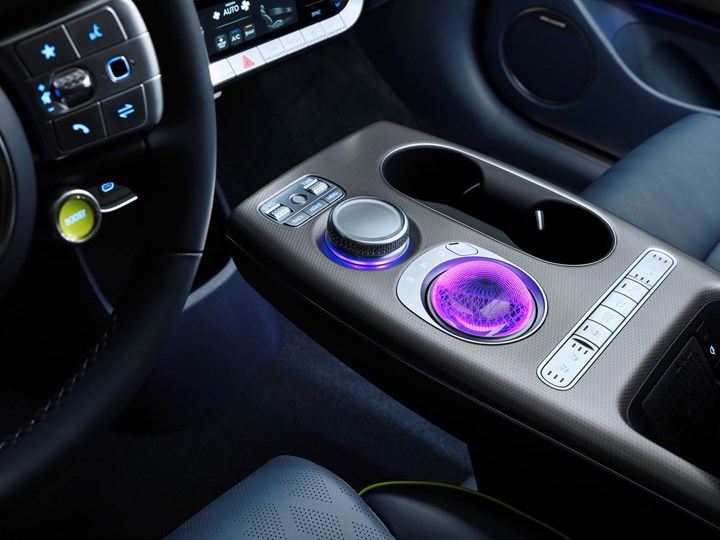
When is the last time you saw a purple-glowing crystal object in a vehicle (alien abductions, notwithstanding)? (Image: Genesis)
Apologies to Thomas Dolby aside, that title came to mind vis-à-vis the Crystal Sphere in the Genesis GV60 electric crossover. (No, not a Buick.)
The glass sphere is laser etched on its inside surface with the Genesis G-Matrix design signature.
Not just a design element, the Crystal Sphere is functional.
When the vehicle is started, it rotates 180 degrees. A dial that allows gear selection is thereby exposed for the shift-by-wire system.
When the vehicle is put in reverse, the color changes to red. When the vehicle is charging it won’t rotate, thereby not allowing the driver to select a gear.
Luc Donckerwolke, Chief Creative Officer at Genesis:
“As the GV60 is an electric vehicle, it is naturally extremely quiet, making it a challenge to alert the driver that the car is ready to drive. Our engineering and design teams collaborated closely to create this unique and captivating way for the driver to engage with the vehicle through the Crystal Sphere, which comes to life by revealing the shift dial after a click of the start button. Combining form with function, Crystal Sphere embodies Genesis’ commitment to offer unrivaled technology, premium design and driver appeal.”
The GV60 is presently available in California, Connecticut, New Jersey and New York.
That orb makes me wonder about vehicle availability on Proxima Centauri b.
>>>
EV Sales in the First Half
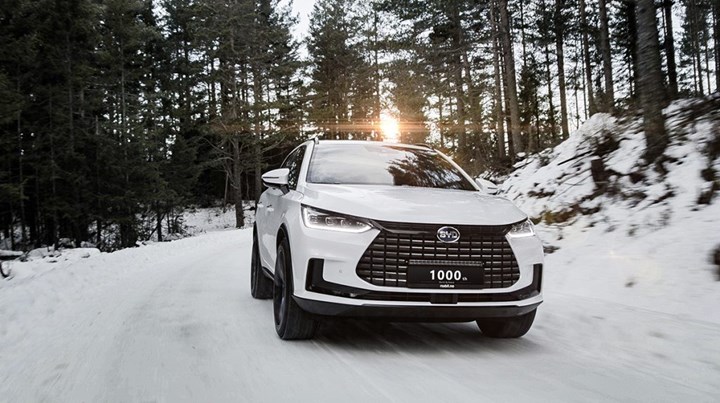
The BYD Tang, the 9th biggest selling electrified vehicle in China during the first half of 2022. (Image: BYD)
With the continued fascination with Tesla and the announcements related to opened and closed order books for things like the Ford F-150 Lightning and the Cadillac LYRIQ, one might conclude that the EV market in the U.S. is booming.
Comparatively speaking, nope.
That is, according to analyst firm Canalys, while global EV sales were up 63% in the first half of 2022 compared with the same period in 2021, the vast majority of those vehicles were purchased in China.
According to Jason Low, principal analyst at Canalys, “57% of global EV sales were in Mainland China. With 118% year-on-year growth, it is the fastest-growing market as well.”
The U.S.?
Canalys has it as representing 10% of the global EV market. Certainly 10% isn’t nothing, but still. . . .
Even though Canalys calculates that EV sales in Europe lost momentum in the first half, it still represents 27% of the global EV market.
It may be interesting to know that BYD, not Tesla, has the greatest percentage of global EV market share, 15%, though admittedly Tesla is just one point behind.
The key reason for that is that BYD sells a lot of vehicles in China.
Canalys puts the top-10 selling vehicles in China in the first half at:
- Wuling Hong Guang Mini: 208,000 units
- BYD Song*: 159,000
- Tesla Model Y: 135,000
- BYD Qin*: 133,000
- BYD Han*: 97,000
- Tesla Model 3: 62,000
- Li Auto One: 60,000
- BYD Dolphin: 59,000
- BYD Tang*: 56,000
- BYD Yuan: 55,000
(Note: Those vehicles marked * are a combination of full battery electrics and plug-in hybrids.)
To put those numbers into context: the extremely popular Mustang Mach-E had first-half U.S. sales of 17,675 units.
But to put the U.S./China numbers into context: there are some 228-million drivers in the U.S. and 418-million in China (per Statista).
>>>
Some Interesting Bentley Bentayga Numbers

Ten hours in the Wood Shop. . . .(Image: Bentley)
The Bentley Bentayga is not a small SUV, with a length of 201.8 inches, a wheelbase of 117.9 inches, width of 78.7 inches and height of 68.5 inches.
However, at the Southampton International Boat Show (I am not making this up) in the U.K. next month, those who are looking for yachts will have their first opportunity to see what could be considered a something of a sumptuous land yacht, the Bentayga EWB, as in “extended wheelbase.”
Both the length and the wheelbase are increased by 7.1 inches, making the former 208.9 inches and the latter 125 inches.
This number is more astonishing: it requires more than 132 hours to build a Bentayga EWB at the company’s factory in Crewe, England.
In the Wood Shop
And some 10 hours are spent in the Bentley Wood Shop, shaping and polishing the wood veneer used on the instrument panel.
The new SUV will provide an optional “Metal Overlay in Veneer” for the instrument panel, which uses a photo-etching process.
In that execution, the metal features applied to the surface of the wood are just 0.07-mm thick.
A more incredible number
While most OEMs are actively working to minimize the number of variants offered in order to simplify, and thereby reduce the cost of, manufacturing, according to Bentley there are 24 billion trim combinations “and a total number of possible specifications running into the trillions” (a.k.a., 1,000,000,000,000s).
Of course, most OEMs don’t have the extensive use of hand craftsmanship and, perhaps more importantly, an MSRP north of $200,000.
>>>
The Importance of Automated Movement

Matt Myrand: Finding the ways and means to improve the manufacturing operations at Faurecia. (Image: Faurecia)
Faurecia is a global supplier that has four business groups: Seating, Interiors, Clean Mobility, and Electronics. Its manufacturing operations are on all continents with the exceptions of Australia and Antarctica. The company performs a wide array of production operations, from stamping and forming seat components to creating hydrogen tanks.
In other words: A wide-ranging operation both in scope and product.
We asked Matt Myrand, manufacturing innovation director, Faurecia, what one of the areas that he and his team are finding to be key to gaining improvements in manufacturing operations.
- Know that they are working with digital twins.
- Are deploying MES.
- Investigating the potential of additive manufacturing (“Right now the speed and quality aren’t there to keep up with the typical 45 to 60-second takt time.”).
- Are developing AI tools for automated visual inspection.
A big boost for manufacturing?
Material handling.
“We have a lot of people moving parts around, handling parts, moving finished goods from the assembly line and so on,” he says, explaining that the automation of parts and products can be highly beneficial.
Make no mistake: they have AGVs and other material handling systems in the plants.
They are looking for other ways to automate movement.
One intriguing way comes from a company out of Norway, wheel.me.
Free-wheelin’
It produces an omnidirectional, autonomous wheel system. Each wheel has a 100 kg capacity, so a set of four wheels allows handling a 400-kg load.
The “Genius” wheel allows what are otherwise static objects (e.g., racks) to become not only mobile, but mobile with the ability to autonomously negotiate through manufacturing operations.
Suddenly, what are otherwise so-called fixed objects go mobile once the wheels are affixed to their undersides.
Mobility is a considerable area of focus at Faurecia. Myrand points out that they are putting cobots on AGVs so that assembly operations, say torquing fasteners on a seat assembly, can be performed while a line is moving.
>>>
What People Pay for Luxury

Yes, the Cadillac LYRIQ gets warranted attention. But the Escalade is really important to the fortunes of Cadillac. (Image: Cadillac)
While this could be something of an inside baseball consideration—although given the topic, perhaps “inside baccarat” would be more appropriate—there is sometimes a squabble as to whether Tesla should be categorized as a purveyor of luxury vehicles.
If one takes “luxury vehicle” as something distinct from a mainstream vehicle predicated on sticker price (although the new base MSRP for a Ford F-150 Lightning Platinum, $96,874, certainly puts it in rarified air), then based on the Kelley Blue Book calculation of average transaction prices (ATPs) paid by consumers in July certainly indicates that with an ATP of $69,255 Tesla makes the grade.
Look at the ATPs for other OEMs that are certainly categorized as “luxury”:
- Audi: $61,398
- BMW: $67,770
- Lexus: $55,801
- Mercedes: $67,558
That’s right: people paid more for their Teslas than any of those marques (on average, of course).
Here’s a surprising ATP:
- Cadillac: $70,603
There’s something to be said for having an Escalade in the lineup.
>>>
Porsche Quick and Costly
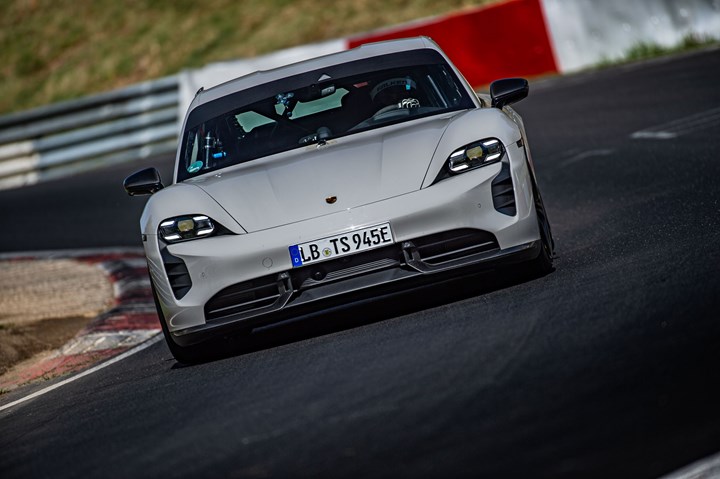
Should you find yourself at the Nurburgring, you might want to be behind the wheel of one of these. (Image: Porsche)
The Porsche Taycan Turbo S—an EV with a starting MSRP of $187,400—is quick.
0 to 60 in 2.6 seconds.
But the folks in Stuttgart weren’t satisfied with that. So they hired a notary and headed off to the Nürburgring Nordschleife with a 2023 Taycan Turbo S. The EV was a standard production vehicle expect that there were a roll cage and racing seats added.
And it has a performance kit that includes things like 21-inch RS-Spyder wheels wrapped with Pirelli P Zero Corsa tires and a software update to the Porsche 4D Chassis Control.
Porsche development driver Lars Kern took the Taycan out on the 20.8-km circuit and ran a lap at 7 minutes, 33 seconds. That is claimed (and confirmed by TÜV Rheinland) to be a record for a series production EV.
Even notarized.
About that option. . .
One thing about that performance kit, which is currently available only in Germany:
Including a 19% VAT, it is priced at €13,377.32.
Were it available in the U.S. that would be approximately $13,700.
So to get a Taycan Turbo S that would be potentially record-setting, that would be $201,100.
Of course, this is probably one of those “If you have to ask the price you can’t afford it” situations.
>>>
Urus Sets New Record on Pikes Peak
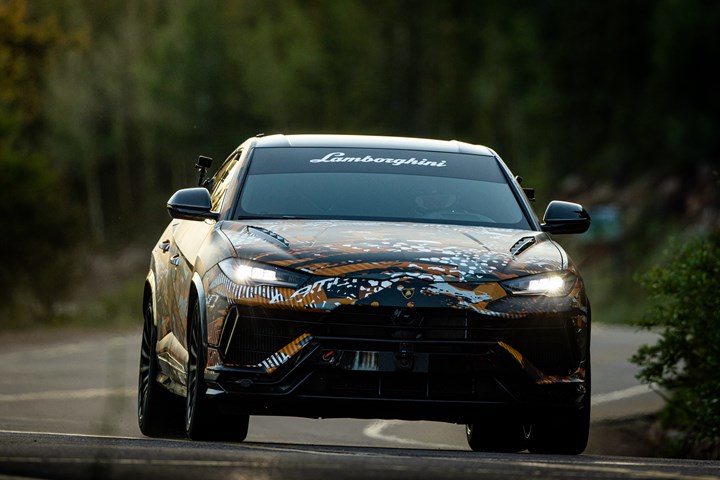
Should you finding yourself on Pikes Peak and wanting to go really fast in an SUV, you might want to be behind the wheel of this. (Image: Lamborghini)
Speaking of expensive vehicles going fast. . .
The refreshed Lamborghini Urus SUV will soon be unveiled at the Concours d'Elegance at Pebble Beach.
But in anticipation of that, the folks at Sant’Agata Bolognese decided to take a camouflage-covered version of the new ~$220K SUV to Colorado Springs for a run on the track used for the Pikes Peak International Hill Climb (PPIHC).
This wasn’t part of the actual PPIHC, which was run on June 26, not August 10, when the Urus took the starting position.
That said, Lambo employed the official Pikes Peak International Hill Climb timekeepers for the run.
The Urus was standard, though modified with a roll cage, race seat with six-point harness, and fire extinguishing system.
Simone Faggioli, Pirelli test driver, ran the 156-turn route and completed the 12.42-mile course in 10:32.064.
That bests the race-day record of 10:49.902 set by Rhys Millen in 2018. . .in a Bentley Bentayga. (Odds are, Millen didn’t pay a whole lot of attention to the wood interior trim.)
>>>
2022 Toyota Avalon Hybrid Limited

Should you be the kind of person who doesn’t like to spend a whole lot of time at gas stations, you might want to be behind the wheel of this. (Image: Toyota)
Toyota is a company that makes mass-market vehicles with a product-offering strategy that essentially has something in the showroom for people who are interested not only in different vehicular architectures (i.e., sedan, crossover, minivan, pickup), but in different price points.
A bit of history
Back in 1994 Toyota launched a new sedan on the U.S. market, which, at the time, was the first Toyota vehicle exclusively built in the U.S., at the Georgetown, Kentucky complex.
The Avalon.
Prior to that, Toyota had offered the Cressida as its top-of-the-line product. The Cressida was a sedan available in many markets around the world.
Not only was the Avalon built in the U.S., but that first model was designed and engineered in California and Michigan.
The company knew what its target market was, so it wanted to address it with people who lived there.
A historical demographic
The target market at the time included people who drove vehicles like the Buick Park Avenue. It was a market consisting primarily of those who were, well, on the right side of the chronological bell curve. Although one could argue that those people probably didn’t have a whole lot of new cars in their future, one could also argue that minute-by-minute there were more entering that demographic category.
The Buick Park Avenue went away. In fact, all Buick sedans went away.
But the Avalon endured.
In all there were five generations, with the last generation being launched in 2019.
For the history books
And it is the last generation. As in no more Avalons after the current model year.
In effect, the Toyota Crown will be the replacement. But it is an entirely different type of vehicle.
Early on I remember talking to a then-Toyota exec about the Avalon. He explained to me it was a car that could be purchased by someone who wanted something lush and plush without buying, say, a Lexus ES 300 because that might seem too ostentatious. A good, solid Toyota wouldn’t be considered a bit on the high side to the neighbors or the clients of the life insurance salesman.
I would argue the positioning of the Avalon, while probably useful at the start, should have been adjusted over time.
Like the first take on the Toyota Venza, which was launched in 2008 and ended in 2015*, the Avalon was targeted on elder urban sophisticates.
No one, not even elder urban sophisticates, wants to think of themselves in the context of that first adjective.
As the rule in automotive marketing has it: You can sell an old man a young man’s car, but you can’t sell a young man an old man’s car.
And that, I submit, was the problem with the Avalon.
It should have been pitched at the same range of people who might buy a Camry but who wanted more.
Not your ordinary ride
Although classified as a midsize, this is a large, stylish sedan:
Size and style really aren’t limited to a chronology-based demographic.
The car is 119.9 inches long with a 113-inch wheelbase and a height and width of 56.5 and 72.9 inches, respectively. With a moon roof it has a passenger volume of 102.2 cubic feet and if you forego that the volume goes to 103.8 cubic feet.
Who doesn’t want roominess?
The Hybrid version is, in a word, remarkable.
Here is a roomy, well-appointed (leather, premium audio, head-up display, Toyota Safety System 2.5+, etc., etc., etc.) sedan that has a fuel economy number on the window sticker of 43 mpg.
Regardless of the price of gas on any given day (and the Avalon Hybrid takes regular), 43 mpg is nothing to sniff at.
While the total system output (2.5-liter four and the electric motor/generator setup) is 215 hp, which is not going to result in any head-snapping takeoffs, it is fully capable of providing what’s needed during normal driving.
All of which is to say that if you’re looking for something large, lux and not breathtakingly expensive (base MSRP: $43,550), you might want to try to find an Avalon Hybrid while you can.
*Although there is a Venza that was launched in 2020, this hybrid-only crossover is probably named “Venza” only because they had the name registered so it was handy. There is very little similarity between the first-generation Venza and the current one.
>>>
Silverado ZR2 Bison’s Boron Steel
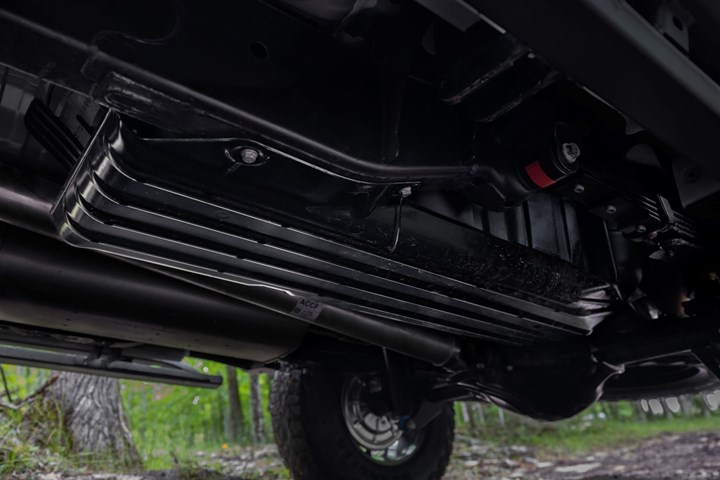
What you would see if you crawled under a Silverado ZR2 Bison. (Image: Chevrolet)
Although the new Chevy Silverado ZR2 Bison starts with the ZR2 trim and then makes it even more off-road capable, as in, for example, having an increased front approach angle (~32.5 degrees), that photo above is one aspect of the truck that Chevy collaborated on with American Expedition Vehicles that you’re not likely to see.
That’s the hot-stamped boron steel skid plate protecting the fuel tank.
Hot-stamped boron steel—which according to Chevy is 3.5 times stronger than an equivalent cold-stamped high-strength steel—provides protection for the front and rear differentials and the transfer case, as well as the fuel tank.
And there’s more. . .
And while on the subject of steel: there are AEV stamped and powder and e-coated bumpers in the front and back made with 3-mm thick steel.
Yes, yes, there are Multimatic 40-mm spool-valve dampers, 18-inch AEV wheels and 33-inch Goodyear Wrangler Territory MT tires, specific off-road chassis and suspension calibrations, exclusive interior trim, and more.
But where else are you going to see the skid plates?
(BTW: there is an 11.2-inch ground clearance, so if you’re so inclined you can probably get under there.)
+++
RELATED CONTENT
-
On French Concept, Inclusive Mobility, Nissan Frontier, and More
French conceptual mobility vehicles, VW addresses mobility for the disabled, a look at the 2022 Nissan Frontier, MINI surveys people about EVs, engineering the Sportster S engine, Honda’s avatar robot, and a driver shortage addressed
-
On EV's, ADAS, and a Pickup Truck
Several industry-related items that you’ve not likely to have seen anywhere else. (At least not all together.)
-
Torc Robotics Shows Snowy Self-Driving Car Test
Blacksburg, Va.-based Torc Robotics has released a video showing a prototype autonomous car navigating public streets during a spring snowstorm.


.jpg;width=70;height=70;mode=crop)






